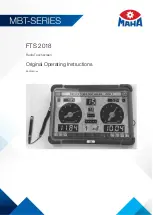
FluoroMax-3 v. 3.1 (3 Mar 2006)
Troubleshooting
7-8
Note:
If the instrument is out of calibration by more than 50 nm, the
Rayleigh scatter band (intense) can be mistaken at first glance for the
water Raman peak (much weaker). Try scanning to 600 nm (instead
of 450 nm) to help ensure that the water Raman peak is found.
If a spectrum similar to this is obtained after running a water Raman scan,
1
Rotate the cuvette 90° and rerun the scan.
If the problem goes away, then the problem was due to the cuvette surface. Clean or use
a different cuvette.
Or
1
Clean the cuvette.
2
Fill with fresh, double-distilled, deionized water.
If the problem goes away, then the problem was due to contaminated water.
Light not striking cuvette
The following graph shows a normal water-Raman scan with a superimposed problem
scan.
Here the problem is low intensity of the water signal when compared with the superim-
posed typical water Raman scan. To resolve this problem:
Low intensity during a Raman scan.
0
1
2
3
4
5
365
380
395
410
425
440
455
Wavelength (nm)
Intensity (10
5
counts/s)
Clean water
Low signal
Summary of Contents for FluoroMax-3
Page 5: ...FluoroMax 3 v 3 1 3 Mar 2006 v 15 Declaration of Conformity 15 1 16 Index 16 1...
Page 6: ...FluoroMax 3 v 3 1 3 Mar 2006 vi...
Page 18: ...FluoroMax 3 v 3 1 3 Mar 2006 Introduction 0 12...
Page 36: ...FluoroMax 3 v 3 22 Feb 2005 System Description 2 8...
Page 96: ...FluoroMax 3 v 3 1 3 Mar 2006 Maintenance 6 12...
Page 156: ...FluoroMax 3 v 3 1 6 Mar 2006 Automated Polarizers 10 22...
Page 208: ...FluoroMax 3 v 3 1 6 Mar 2006 Bibliography 14 4...
Page 210: ...FluoroMax 3 v 3 1 6 Mar 2006 Declaration of Conformity 15 2...
















































